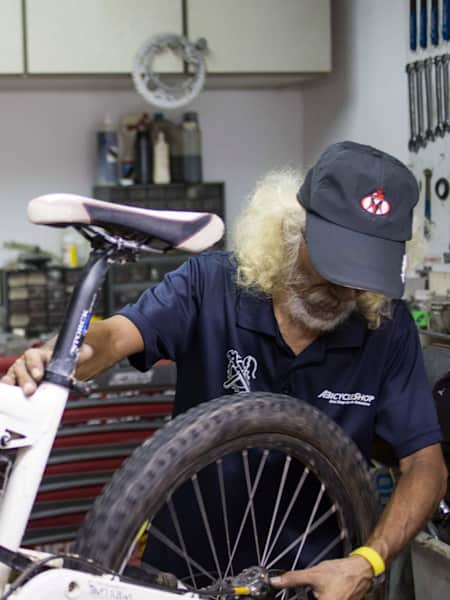Bike
Keeping your bike in tip-top shape is key to enjoying that perfect day out riding. But for those of us who aren’t virtuosos with bike repair, clearing out the cocktail of sweat, sand, mud and grime that collects on our chains; gets lodged between the derailleurs; and on our shocks can be a challenge. That’s when we can turn to the friendly mechanics at our local bicycle shops for help.
Thirty-year veteran mechanic Ahmad, from boutique outfit A Bicycle Shop, takes time out from the workshop to give us the low-down on what happens during bicycle servicing.
Half or Full Servicing?
“Your mechanic will usually check the condition of your bike before advising on what needs to be done,” says Ahmad.
“Half-servicing usually happens after a ride and for bikes that are generally in good condition."
"That’s when we’d wash out the bike and clean out the dirt and grime that collects on the drivetrain (the cranks, chain, cassette, derailleurs). We’d also tune the wheels, bleed the brakes (to ensure enough brake fluid) and check that they’re well aligned,” Ahmad explains.
“Full-servicing, is what we consider an overhaul. This will see us dismantle the entire bike."
"From the headset all the way down to the hubs on the wheels. Every single part of the bike will be stripped down piece by piece, cleaned, greased and reassembled,” he added.
Ahmad also commented that servicing includes replacing parts like the cables used to shift the gears and depending on the condition, the cable housing as well.
How often should we service our bicycles?
“It really depends on how often you ride,” shares Ahmad. “For the weekend warrior, once every three to four months is about right. As for what we need to do to the bike, it all depends on the condition of it.”
What are the key areas you inspect first?
“We will first look at the drivetrain for wear and tear. That’s the chain, cassette, derailleurs and crank. It’s the key part that moves the bike. Following that, I’d look at brakes, cables and the suspension for any fluid leaks. If all’s good, we’d clean it out and oil it up."
But checks shouldn’t just be after a ride. Ahmad recommends that riders should always do a quick pre-ride check before pedalling out.
The first thing to take note of should be the brakes. “Make sure that they’re biting well by squeezing the levers,” he says.
“Next”, he details, “check your gears. Don’t start riding off the moment you get on your bike. Take a moment to spin the crank to gears as the gears might have been adjusted in transit or when you weren’t riding. The chain might sometimes get caught in the cassette.”
Changing Parts
One could also do visual checks on the wear and tear parts. For example, the teeth on the front and rear cassette have markers that show their wear. Like tyres and their ‘wear out’ markers, how worn out the teeth are can be seen by how well the chain rests on them.
“There should not be any obvious gaps when the chain rests on the chain ring. The same goes for the jockey wheels on the rear derailleur."
Likewise, the condition of the chain can be gauged this way. Although the most accurate way would be to check with a chain measurement tool.”
That said, the manufacturers of the various parts on a bicycle, like the chain and suspension, usually have recommended servicing guidelines. And these could range from hours of riding to mileage clocked. When in doubt, check with your mechanic. Specifically for brakes, Ahmad recommends that brake pads be replaced every six months for safety.








